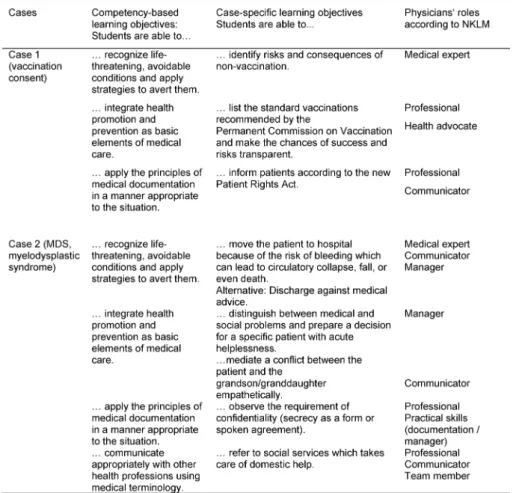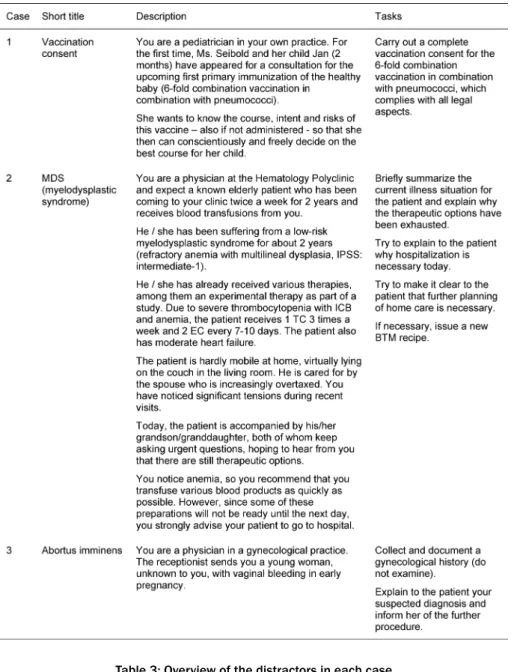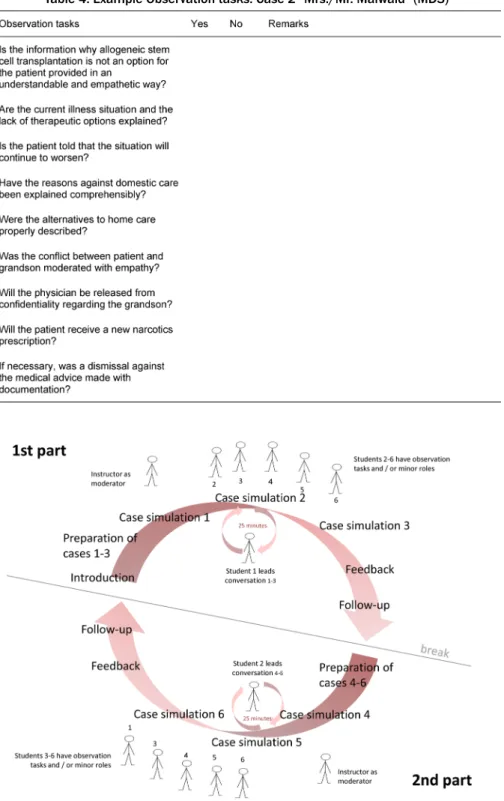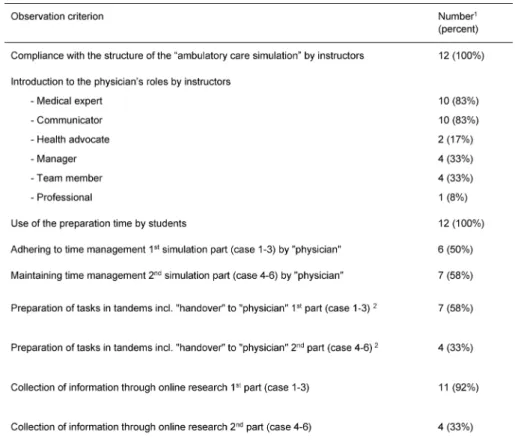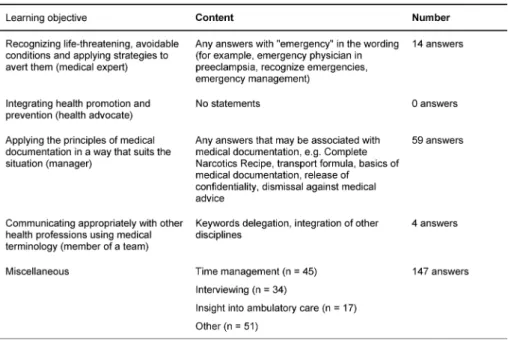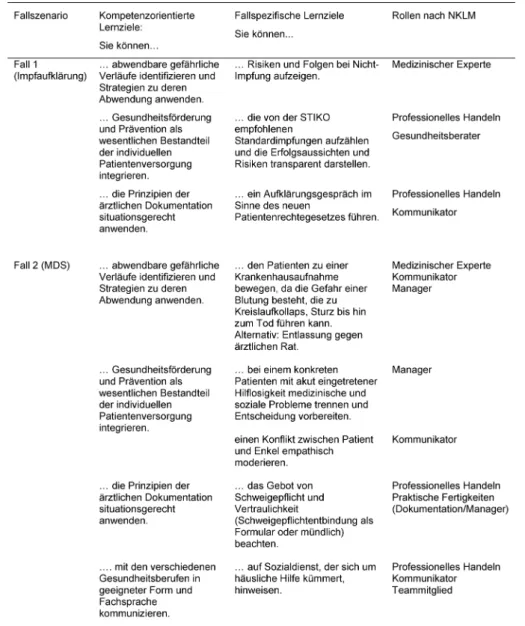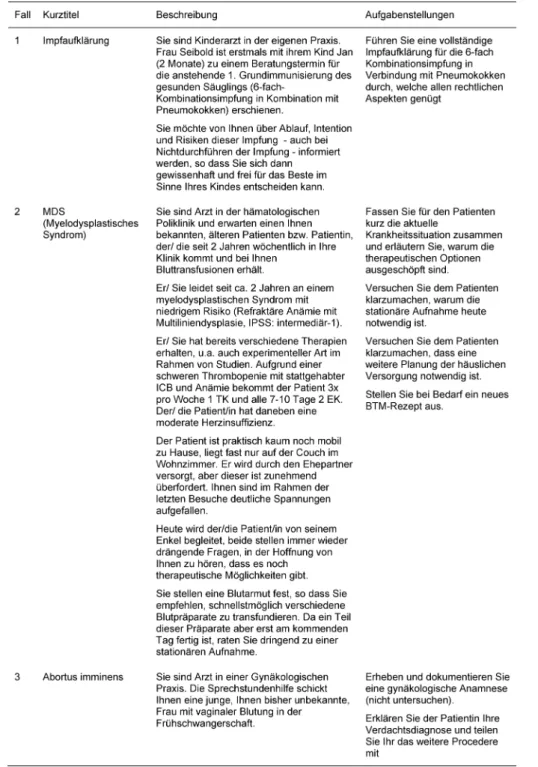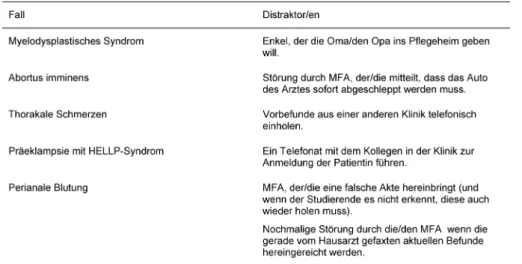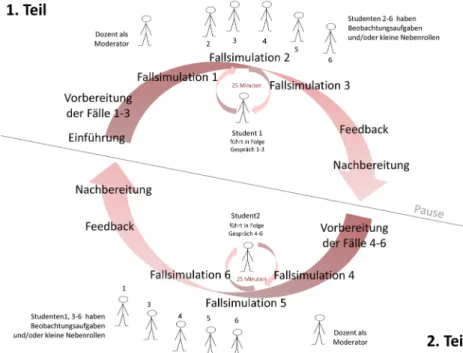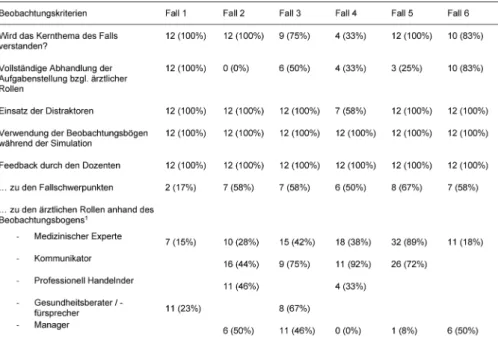Physicians’ roles in competency-based teaching: Do students recognize them?
Abstract
Introduction:Imparting the concept of physician’s roles with the help of new teaching formats is becoming increasingly important in medical
Elvira Pippel
1Elisabeth Narciß
1education. The “ambulatory care simulation” was developed at the
Udo Obertacke
1Medical Faculty Mannheim as a format to teach the roles of "medical
Renate Strohmer
1expert," “communicator”, “health advocate”, “manager”, “team member”
and “professional” in the practical year. During the “ambulatory care
Katrin
Schüttpelz-Brauns
1simulation”, students work through case scenarios with simulated pa- tients focusing on the physician’s roles and subsequently discussing and reflecting on their experiences. Several measures are designated
to ensure that each role is covered by the new teaching format. The 1 Medical Faculty Mannheim, Heidelberg University, present study investigates whether the physician’s roles are actually
addressed during the “ambulatory care simulation” and whether the competency-based learning objectives are recognized by the students.
University Medicine Mannheim (UMM), Mannheim, Germany Methods:All participants in 12 of the 38 obligatory “ambulatory care
simulations” signed informed consents to be filmed during the “ambu- latory care simulation”. These videos were categorized using previously defined observation criteria. A total of 211 out of 224 students com- pleted and handed in a one-minute paper at the end of the “ambulatory care simulation”. The answers to the question, “What have you learned?”
have been assigned to competency-based learning objectives.
Results:Although instructors and students adhered to the guidelines in the recorded “ambulatory care simulations”, the most frequently addressed roles were “medical expert” and “communicator.” Two-thirds of the participants indicate learning outcomes that do not correspond to the previously defined learning objectives of the “ambulatory care simulation”.
Discussion:To ensure a thorough understanding and long-lasting appre- ciation of the physician’s roles, longitudinal integration of teaching in- terventions into the curriculum is to be favored over single teaching units. Instructors need intensive preparation for the unfamiliar construct of physician’s roles. The learning objectives must also be made more transparent.
Conclusion:Especially complex teaching formats need to be evaluated for success if they are to achieve their aims. Formative evaluations en- able verification of whether the learning objectives are
1. addressed,
2. recognized and, finally, 3. achieved.
Keywords:competency-based education, program evaluation, simulation training, undergraduate medical education
Introduction
There is an increasing demand for competency-based medical education both internationally and here in Ger- many. In the 1990s, the CanMEDS framework was de- veloped in Canada to describe the different roles of a physician that are needed for the practical pursuit of the profession [1]. In 2014 the German Science Council
called for training tailored to physician’s roles and com- petencies [2]. In 2015 the Medical Faculty Association passed the National Catalogue of Competency-based Learning Objectives for Undergraduate Medicine (NKLM) [http://www.nklm.de]. Here, the graduate profile is defined for the first time, thus delineating a core cur- riculum. This includes various physician’s roles that reflect the different expectations of future physicians (for ex- ample, in communicative and economic terms).
The simulation is a method to teach physician’s roles and prepare for contact with patients [3], [4], [5]. So far, simulation scenarios have been used in the context of practical skills, physical examinations and medical inter- viewing. Working with simulation patients (SP) is seen as meaningful and accepted by both students and practition- ers [6].
Since 2006 at the Medical Faculty Mannheim of Heidel- berg University, the final year is divided into quarters in- stead of the usual tertiary. In addition to the two mandat- ory rotations of internal medicine and surgery plus an optional rotation, the medical students complete one ro- tation in one of the four areas offered in ambulatory medicine, namely the fields of interventional surgery, conservative long-term care, oncology, or psychiatry &
psychotherapy. This is intended to reflect the increasing focus on ambulatory care of medicine [7], [8]. The ambu- latory quarter of the final year is carried out in specially selected ambulatory care clinics at the university hospital and its teaching hospitals, as well as at specialized cen- ters and medical practices. The students are only de- ployed in ambulatory care clinics or practices where they can get to know patients over the course of their disease.
“Ambulatory Care Simulation” as Teaching Format
As part of a MME project thesis, an “ambulatory care simulation” was developed to introduce medical students to the ambulatory care rotation. Designed as a compet- ency-based teaching format, the aim of the simulation is to prepare students in the final year for their work in the ambulatory healthcare sector and, ultimately, for their future professional life [9]. In addition to the physician’s roles of “medical expert” and “communicator”, the final- year students in this class should also be made aware of their roles as “health advocate”, “manager”, “team member” and “professional”. The following learning ob- jectives are defined:
Students are able to
1. … recognize life-threatening, avoidable conditions and apply strategies to avert them;
2. … integrate health promotion and prevention as basic elements of medical care;
3. … apply the principles of medical documentation in a manner appropriate to the situation;
4. … communicate appropriately with other health pro- fessions using medical terminology.
These general learning objectives are taken directly from the NKLM and are, as far as possible, addressed in each of the cases used in the “ambulatory care simulation”.
Case-specific learning objectives, also taken from the NKLM, were derived from these learning objectives. Ac- cordingly, the general learning objectives and case-spe- cific learning objectives can be directly assigned to the physician’s roles. A list of examples of the general learning objectives, the case-specific learning objectives and the
corresponding assignment to the physician’s roles in the NKLM can be found in Table 1.
The “ambulatory care simulation” was designed as a single mandatory course for all final year students in the ambulatory care rotation with four teaching units. Taking place between weeks 1 and 4 at the beginning of the ambulatory care rotation, the simulation was conducted in the skills lab (TheSiMa) of the Medical Faculty Mann- heim. The students were divided into small groups (6-8 participants). To use resources most effectively, each SP played several cases per course (3 SP for 6 cases).
The following description refers to the revised version of the “ambulatory care simulation”. The original version can be found in Dusch et al. (2018) [9].
Carrying out the “Ambulatory Care Simulation”
In the simulations, two volunteer students from the small group were each asked to interview three unknown pa- tients as a “physician” and to make diagnostic and/or therapeutic decisions in a given space of time (about 7 minutes per case). We discussed the cases and tasks required of the cases in detail with the individual case authors. Example versions of the cases for the students can be found in Table 2. Each student had 25 minutes to become familiar with the cases. In doing so, they were also able to search online for information needed to solve the cases. During the simulation, the “physicians” had access to a consultation room equipped with a desk, telephone, documentation system and a clock.
We included distractors in several cases to present an additional challenge. These were tasks that unexpectedly came up during the cases and either involved an addition- al, unexpected task, such as obtaining information over the telephone (e.g., previous findings from another hos- pital) or an actual disturbance, such as an uninvolved medical assistant coming in and asking a question in the middle of the case (played by one of the fellow students).
When creating the cases, care was taken to ensure that the distractors were logically and practically integrated into the cases (see Table 3).
The simulation was divided into two parts with three cases each (part 1: case 1-3, part 2: case 4-6). During these two parts, fellow students and instructors were required to use an observation sheet to evaluate various aspects of each case. In the subsequent debriefing, the sheets served as basis for the feedback from the instructors and fellow students, as well as for the content-related follow- up (example in Table 4).
The “physician” students received additional feedback from the SP [10]. Specialist content was summarized in sample solutions and handed out to all students following the ambulatory care simulation. An example of the work- flow is presented in Figure 1. The instructor led the “am- bulatory care simulation” by moderating the introduction and the feedback sessions; however, during the two simulation parts he remained a silent observer.
Table 1: Examples of the learning objectives and roles according to NKLM (cases 1 and 2)
Preparation of the “Ambulatory Care Simulation”
Each instructor received an instructor's folder containing information on the introduction and a process overview of the “ambulatory care simulation” including precise descriptions of all cases and comments. Copies of all other materials were made available to both the students and the instructor. This included the tasks for the cases and the case-related observation sheets. To prepare for the “ambulatory care simulation”, each instructor was trained to precisely identify with the students the physi- cian’s various roles in the cases. The preparations were adjusted to fit the schedule of each instructor and took up 45 to 60 minutes.
The students were familiarized with the “ambulatory care simulation” in the introductory phase at the beginning of the final year as well as during a presentation at the be- ginning of the ambulatory care rotation.
Addressing the Competencies in the
“Ambulatory Care Simulation” as a Teaching Format
Various measures were taken to address competencies regarding the physician’s roles using this teaching format.
In the introduction, the instructors should
• explain all physician’s roles according to the NKLM.
In the preparation time for the cases the students should
• prepare the cases together in their small group (“team member”),
• search online for the case (“scholar”).
During the individual simulation runs of the “ambulatory care simulation”, time management should be practiced by:
• processing all three cases within 25 minutes (“man- ager”),
• proper handling of distractors (“manager”).
During the three cases in the “ambulatory care simula- tion”, the students and the instructor received one obser- vation sheet per case. These contained
• observation tasks focusing on the addressed physi- cian’s roles.
During the reflection after a case simulation
• feedback should be provided based on the observation sheets by the fellow students and by the instructor.
All these components should promote the competency- based focus of the “ambulatory care simulation” and thus the development of the physician’s roles.
Table 2: Exemplary cases and tasks for the students (case 1 to 3)
Table 3: Overview of the distractors in each case
Table 4: Example Observation tasks: Case 2 “Mrs./Mr. Maiwald” (MDS)
Figure 1: Schematic sequence of the ambulatory care simulation
How the “Ambulatory Care Simulation”
functions as a Teaching Format
Emphasis on competency-based teaching is steadily in- creasing in medical education. The question is whether these new teaching formats can actually promote com- petencies and represent different physician’s roles.
This study aimed to find out whether the “ambulatory care simulation” actually put the physician’s roles in the spotlight so that they were recognized by the students.
This resulted in the following research questions:
• Are the physician’s roles addressed during the runs of the “ambulatory care simulation”?
• Are the competency-based learning objectives recog- nized by the students?
For the first question, the following points should be cla- rified:
• Does the instructor explain the physician’s roles in the introduction?
• Do the students prepare the cases as a team and via online research?
• Do “physician” students pay attention to the time (25 minutes per simulation part) and are the distractors used?
• Do fellow students and instructors use the observation sheets during the simulation parts?
• Does the instructor provide feedback based on the observation tasks?
Method
Sample
In 38 simulation runs, 12 different instructors with vast ambulatory care experience in different fields were in- volved (including pain ambulance, gynecology, urology).
From May 2014 to November 2015, a total of 224 under- graduate medical students attended the mandatory
“ambulatory care simulation”. Four runs were performed according to the originally developed concept of “ambu- latory care simulation” (MME project version), 34 runs according to the modified concept. This study refers to the revised “ambulatory care simulation”.
Material
For 12 runs of the “ambulatory care simulation”, instruct- ors and all participating students signed an informed consent form to film the run. Videos were used to assess whether physician’s roles were addressed by the instruct- ors during the introductions and debriefings and whether the intended physician’s roles were addressed in the cases. Seven different instructors moderated the runs.
Two instructors had been involved with the teaching format from the beginning and also participated in the development of the cases. The other five instructors were introduced to the teaching format and moderated the runs at least two times.
A one-minute paper at the end of each run contained the open-ended question: “What did you learn?” and asked whether the previously defined learning objectives were recognized by the students.
Procedure
Each participant went through the “ambulatory care simulation” once at the beginning of his/her ambulatory care rotation. On several occasions students were in- formed about the possibility to voluntarily participate in the study. Signed consent forms were obtained from the participants after sharing the pertinent information. The simulations were filmed only if all participants had given their written consent. To allow a full view, both the group work and the simulation parts and the debriefings were recorded. After the run, students were asked to complete the one-minute paper. The Ethical Review Board of Med- ical Faculty Mannheim, Heidelberg University, approved the study (2014-554N-MA of 6.5.2014).
Statistical Analysis
The evaluation of the video recordings was based on a structured observation sheet developed by us covering the following categories:
Related to the run of the “ambulatory care simulation”
• Maintaining the structure of the “ambulatory care simulation” by instructors
• Introduction to the physician’s roles by instructors
• Use of the preparation time by students
• Maintaining time management during the simulation parts by the “physicians”
• Preparation of the cases in the small group
• Collection of information through online research Related to the single cases
• Understanding the core issue of the case
• Completing the task regarding the physician’s roles
• Use of distractors
• Using the observation sheets during the simulation runs
• Feedback from the instructor on the main issues of the case
• Feedback from the instructor on the physician’s roles based on the observation sheet
One of the investigators analyzed the videos. In case of ambiguity, a second investigator could be included in the analysis in order to get a result.
The results of the video analysis were quantitatively evaluated.
Answers on the one-minute paper were categorized ac- cording to the four general learning objectives of the
“ambulatory care simulation”. They were assigned to a learning objective when key terms of the respective physician’s role (NKLM) were mentioned, e.g. “document- ation” which corresponds with the manager role. One person carried out the evaluation. Ambiguous answers were discussed with the head investigator.
Results
Descriptive Results
Table 5 shows that all investigators have adhered to the procedure protocol of the “ambulatory care simulation”.
The core issues of most cases were understood in all simulation runs. In case 4, however, these were only un- derstood in one-third of the simulation runs (see Table 6).
Definition of Competencies and Addressing Physician’s Roles in the Introduction by the Instructor
During the introduction, instructors failed to present the concept of competencies in all recorded scenario runs.
Table 5: Results of the video analysis related to the “ambulatory care simulation”
Table 6: Results of video analyses regarding the single cases
In two videos instructors emphasized that “soft skills are trained here” without specifying them.
Furthermore, the instructors mentioned the physician’s roles of the “medical expert” and “communicator” most frequently during the introduction. The roles “manager”
and “team member” were addressed in one-third of the
“ambulatory care simulation” runs. The physician’s role of “health advocate” was addressed twice.
The detailed results are presented in Table 5.
Preparing the Cases by the Students in the Team and with Online Research
In all “ambulatory care simulation” runs, the students used the preparation time to work on the cases. They also searched for information online. Both the use of the preparation time and the online research were much more frequent in the first simulation part (cases 1-3) than in the second simulation part (cases 4-6). In some runs, the students organized themselves in tandems, so that two people each worked more intensively on one case.
This was followed by a handover to the student who held the physician’s role in the subsequent simulation. Tandem collaboration was not intended at the beginning of the development, but was later taken up by the instructors.
The detailed results are presented in Table 5.
Adhering to the 25-minute Time Limit per Simulation Part
Time management was maintained in about half of all simulation parts. In all other cases, students needed ad- ditional time. In simulation part 1 (case 1-3) the time was exceeded by three to eight minutes in 50% of the runs.
In simulation part 2 (case 4-6) the time was exceeded by four to ten minutes in five cases.
The detailed results are presented in Table 5.
Use of the Distractors in the Cases
Except for case 4, the distractors were used in each case and each run.
The detailed results are presented in Table 6.
Use of Observation Sheets during Simulation Parts
In all simulation runs, the observation sheets were used by both students and instructors to take notes during the cases (see Table 6).
Feedback Based on the Observation Tasks
The role-specific observation tasks were addressed in approximately one-third of all possible cases on the physician’s roles of “medical expert”, “health advocate”, and “manager”. The most frequent feedback was given on the physician’s role as “communicator”. The “profes- sional” was mentioned in 42% of all possible cases in the feedback.
The detailed results are presented in Table 6.
Perception of Learning Objectives by Students
The evaluation of the student's one-minute paper, “What did you learn?” produced a wealth of different answers.
Of the 211 submitted one-minute papers, a total of 224 responses were evaluated. Of these, only 77 answers could be assigned to the four learning objectives and 147
answers were categorized as “miscellaneous”. At least two-thirds of the students recognized other learning ob- jectives than were intended in the “ambulatory care simulation“. Table 7 lists the matching of answers with the four general learning objectives.
Among the most widely recognized and primarily uninten- ded learning objectives were time management (n=45) and interviewing (n=34). In addition, 17 students stated that they have gained a deeper insight into ambulatory medicine through the “ambulatory care simulation”.
Discussion
Competency-based teaching is becoming increasingly important in medical education. However, it is usually not clear whether these new teaching formats actually are able to promote the physician’s roles. With the introduc- tion of the “ambulatory care simulation” in the ambulatory care rotation during the final year at the Medical Faculty Mannheim, a complex competency-based teaching format going far beyond sole communication training with SP was piloted and scientifically evaluated. The aim of this study was to verify if the “ambulatory care simulation”
addresses the different and intended physician’s roles during the simulation and whether the competency-based learning objectives are recognized by the students.
The video analysis showed that both the role of the
“medical expert” and the role of the “communicator” are more frequently addressed by the instructors than the other physician’s roles. This may be due to the fact that these two roles are firmly anchored in the professional self-image of physicians, while the other physician’s roles are not yet so consciously recognized. In addition, there is a communication curriculum in Mannheim which is anchored longitudinally in the undergraduate training and for which the instructors are intensively trained.
An unintentional development was seen in the students’
teamwork during the preparatory phase in which there was separate case preparation with subsequent handover to the student in the physician’s role. We feel this beha- vior should be encouraged in future implementations, since it also addresses the physician’s role as “team member” and gives each of the three tandems a total of 25 minutes to prepare a case instead of the planned 25 minutes for a total of three cases. The collection of inform- ation through an online search was more frequent in the first simulation part than in the second simulation part.
We cannot fully explain the decrease in motivation. Per- haps the case descriptions in the second simulation part contained too few concrete hints for targeted online searching, or the cases themselves were not good, or after the first simulation round the students felt that it was just another communication seminar in the final year.
Since the students of the Medical Faculty Mannheim undergo a complete communication curriculum with SP during the clinical phase of their undergraduate training, their expectation might be to engage in “real patient contact” rather than SP.
Table 7: Assignment of the answers to “What did you learn?” to the four general learning objectives of the “ambulatory care simulation” (N=224)
Results show that the time management for the three cases per simulation part was a real challenge for the students. It turned out that students cannot accomplish such complex consultations within 7 minutes, especially those with built-in interferences. Experienced primary care physicians, who can easily handle simple consulta- tions in 7 minutes (e.g., gastroenteritis / upper respiratory tract infection, dermatological/gynecological or surgical follow-ups), would take more than 10-15 minutes for the cases mentioned here. The aim should therefore be to extend the consultation period or simplify the cases. Since the issue of “time management” is not an explicit part of the curriculum, it should also be discussed in other courses.
The distractors were used in all cases except for case 4 (thoracic pain). As there were also problems with case 4 in other respects, this will need to be revised again. It is important to ensure that the technical complexity is min- imized in favor of the competency-based approach.
Only a few students recognized the four general learning objectives. About two-thirds of the participants learned something different according to their own answers. The topics “time management” and “interviewing” were mentioned several times. Although these were not part of the learning objectives, they were addressed by the teaching format itself and should be included as explicit learning objectives.
All in all, we can conclude that the “ambulatory care simulation” addresses and promotes some of the physi- cian’s roles; however, there must be a stronger focus on the physician’s roles, for both instructors and students.
Complex technical content, as in the MDS case, must be reduced in order to present the physician’s roles more transparently. This could increase the learning success and make the teaching format more attractive for stu- dents since the relevance to the everyday life of the physician would be easier to understand.
This study has two limitations: participation in the “ambu- latory care simulation” was mandatory, but the video re- cordings in this study were voluntary. All participants of one run (students and instructors) had to sign the in- formed consent to film the “ambulatory care simulation”.
This was only the case in 12 of the 38 “ambulatory care simulation” runs. Biases due to voluntary participation can therefore not be excluded. In addition, the one-minute paper was evaluated by only one person.
The literature shows that the transfer of competencies must be longitudinal [10]. Single teaching units are not effective. By contrast, they have to be embedded in lon- gitudinal curricula which explain the physician’s roles in the form of a learning spiral, establish a foundation of knowledge and skills, and then practice these skills in more complex settings. Furthermore, the instructors must be repeatedly sensitized in training sessions to the concept of competency-based instruction and the import- ance of the various physician’s roles.
The competency-based approach of the “ambulatory care simulation” as a teaching format was critically discussed.
The simulation will be revised and embedded differently in the curriculum. The plan is to transfer it from the final year to the clinical phase of undergraduate education and to embed it longitudinally in the newly developed ambulatory care track, thus continuing to promote addi- tional non-communicative and non-knowledge-related skills. This embedding aims at optimizing the effective- ness and usefulness of the teaching format [10], [11], [12], [13]. Instructor training will be revised. In addition to the organizational process and contents of the cases, the concept of competency-based education, the physi- cian’s roles, and the role of the investigator as moderator and mediator in the “ambulatory care simulation” will be discussed in depth.
It is questionable whether other new teaching formats that are introduced would withstand such a critical eval-
uation. How we can find the balance between feasibility, complexity of cases, instructors’ everyday medical prac- tice and necessary preparations for a new teaching format? Only when physician’s roles and the concept of competencies have been made clear to instructors and students alike can a possible transfer to medical practice be observed.
Acknowledgements
We thank Dr. med. Martin Dusch who developed the ori- ginal concept as part of his MME project thesis in collab- oration with the Competence Center of the Final Year Baden-Württemberg and the Educational Research Team of the Medical Faculty Mannheim at Heidelberg University.
Furthermore, we thank Dr. med. Magdalena Kowoll for the literature research and critical reading of the manu- script.
Funding
The preparation and scientific evaluation of the “ambu- latory care simulation” teaching format was funded by the Federal Ministry of Education and Research in the project entitled “MERLIN – Competency-based Teaching, Learning and Assessing in Medicine” (01PL12011L).
Competing interests
The authors declare that they have no competing in- terests.
References
1. Frank JR. The CanMEDS 2005 physician competency framework.
Better standards. Better physicians. Better care. Ottawa: The Royal College of Physicians and Surgeons of Canada; 2005.
2. Wissenschaftsrat. Empfehlungen zur Weiterentwicklung des Medizinstudiums in Deutschland auf Grundlage einer Bestandsaufnahme der humanmedizinischen
Modellstudiengänge. Dresden: Wissenschaftsrat; 2014.
Zugänglich unter/available from: http://
www.wissenschaftsrat.de/download/archiv/4017-14.pdf 3. Cook DA, Brydges R, Zendejas B, Hamstra SJ, Hatala R. Mastery
learning for health professionals using technology-enhanced simulation: a systematic review and meta-analysis. Acad Med.
2013;88(8):1178-1186. DOI:
10.1097/ACM.0b013e31829a365d
4. Issenberg SA, Mcgaghie WC, Petrusa ER, Gordon DL, Scalese RJ. Features and uses of high-fidelity medical simulations that lead to effective learning: a BEME systematic review. Med Teach.
2005;27(1):10-28. DOI: 10.1080/01421590500046924
5. Solga M. Evaluation der Personalentwicklung. In: Ryschka J (Hrsg). Praxishandbuch Personalentwicklung: Instrumente, Konzepte, Beispiele. Wiesbaden: Gabler Verlag I Springer Fachmedien; 2011. S.369-399. DOI: 10.1007/978-3-8349- 6384-0_7
6. Cleland, JA, Keiko, A, Rethans, JJ. The use of simulated patients in medical education: AMEE Guide No 42. Med Teach.
2009;31(6):477-486. DOI: 10.1080/01421590903002821 7. Richter-Kuhlmann E. PJ-Quartalisierung – Vorreiter Mannheim.
Dtsch Ärztebl. 2016;113:A1295.
8. Schüttpelz-Brauns K, Eschmann E, Weiß B, Narciß E, Obertacke U, Schreiner U. PJ Chirurgie im Modellstudiengang MaReCuM (Mannheim). Zentralbl Chir. 2017;142:61-66.
9. Dusch M, Narciß E, Strohmer R, Schüttpelz-Brauns K.
Competency-based learning in an ambulatory care setting:
Implementation of simulation training in the Ambulatory Care Rotation during the final year of the MaReCuM model curriculum.
GMS J Med Educ. 2018;35(1):Doc6. DOI: 10.3205/zma001153 10. Motola I, Devine LA, Chung HS, Sullivan JE, Issenberg SB.
Simulation in healthcare education: a best evidence practical guide. AMEE Guide No. 82. Med Teach. 2013;35(10):e1511- 1530. DOI: 10.3109/0142159X.2013.818632
11. Nousiainen MT, Caverzagie KJ, Ferguson PC, Frank JR, ICBME Collaborators. Implementing competency-based medical education: What changes in curricular structure and processes are needed? Med Teach. 2017;39(6):594-598. DOI:
10.1080/0142159X.2017.1315077
12. Philibert I. Review article: Closing the research gap at the interface of learning and clinical practice. Can J Anaesth.
2012;59(2):203-212. DOI: 10.1007/s12630-011-9639-7 13. Ahlers O. Der richtige Rahmen entscheidet: Curriculare
Implementierung der Simulation. In: Pierre MS, Breuer G (Hrsg).
Simulation in der Medizin. Berlin/Heidelberg: Springer; 2013.
S.77-81. DOI: 10.1007/978-3-642-29436-5_7
Corresponding author:
Dr. Katrin Schüttpelz-Brauns
Medical Faculty Mannheim, Heidelberg University, University Medicine Mannheim (UMM),
Theodor-Kutzer-Ufer 1-3, D-68167 Mannheim, Germany katrin.schuettpelz-brauns@medma.uni-heidelberg.de
Please cite as
Pippel E, Narciß E, Obertacke U, Strohmer R, Schüttpelz-Brauns K.
Physicians’ roles in competency-based teaching: Do students recognize them? GMS J Med Educ. 2018;35(3):Doc37.
DOI: 10.3205/zma001183, URN: urn:nbn:de:0183-zma0011836
This article is freely available from
http://www.egms.de/en/journals/zma/2018-35/zma001183.shtml
Received:2016-05-11 Revised:2018-04-26 Accepted:2018-06-05 Published:2018-08-15
Copyright
©2018 Pippel et al. This is an Open Access article distributed under the terms of the Creative Commons Attribution 4.0 License. See license information at http://creativecommons.org/licenses/by/4.0/.
Adressieren von ärztlichen Rollen in einem
kompetenzorientierten Lehrformat: Nehmen Studierende diese wahr?
Zusammenfassung
Einleitung:Die Vermittlung von ärztlichen Rollen mit Hilfe neuer Lehr- formate gewinnt in der medizinischen Ausbildung immer mehr an Be-
Elvira Pippel
1Elisabeth Narciß
1deutung. Das Lehrformat „Ambulanzsimulation“ wurde an der Medizini-
Udo Obertacke
1schen Fakultät Mannheim entwickelt, um die ärztlichen Rollen „Medizi-
Renate Strohmer
1nischer Experte“, „Kommunikator“, „Gesundheitsfürsprecher“, „Mana- ger“, „Teammitglied“, sowie „Professionell Handelnder“ im Praktischen
Katrin
Schüttpelz-Brauns
1Jahr zu vermitteln. In der „Ambulanzsimulation“ werden Fallszenarien mit Fokus auf die ärztlichen Rollen mit Simulationspatienten durchge- führt und im Anschluss besprochen und reflektiert. Verschiedene
Maßnahmen sollten sicherstellen, dass die ärztlichen Rollen während 1 Medizinische Fakultät Mannheim der Universität der Lehrveranstaltung auch adressiert werden. Die vorliegende Studie
soll untersuchen, ob die ärztlichen Rollen während der „Ambulanzsimu- Heidelberg, Universitätsmedizin lation“ tatsächlich adressiert werden und ob die kompetenzorientierten
Lernziele von den Studierenden erkannt werden. Mannheim (UMM),
Mannheim, Deutschland Methode:Von 12 der 38 verpflichtend durchgeführten Durchgängen
der „Ambulanzsimulation“ liegen Einverständniserklärungen aller Teil- nehmer für das Filmen der „Ambulanzsimulation“ vor. Diese Videos wurden anhand vorher definierter Beobachtungskriterien kategorisiert.
211 von 224 Studierenden haben im Anschluss an das Lehrformat ein One-Minute-Paper ausgefüllt und abgegeben. Die Antworten zu der Frage „Was haben Sie gelernt?“ wurde den kompetenzorientierten Lernzielen zugeordnet.
Ergebnisse:Obwohl sich in den aufgenommenen „Ambulanzsimulatio- nen“ sowohl Dozenten als auch Studierende an die Vorgaben hielten, wurden v.a. die bekannten Rollen des „Medizinischen Experten“ und des „Kommunikators“ adressiert. Zwei Drittel der Teilnehmer geben Lernerfolge an, welche nicht den vorher festgelegten Lernzielen der
„Ambulanzsimulation“ entsprechen.
Diskussion:Einmalige Lehrveranstaltungen zur Vermittlung ärztlicher Rollen bewirken keine nachhaltige Wahrnehmung der ärztlichen Rollen.
Vielmehr müssen diese longitudinal in die Curricula integriert werden.
Dozenten benötigen eine intensive Vorbereitung auf das ihnen unver- traute Konzept der ärztlichen Rollen. Die Lernziele müssen darüber hinaus transparenter gemacht werden.
Schlussfolgerung:Gerade bei aufwändigen Lehrformaten muss geprüft werden, ob sie ihr Ziel erreichen. Durch formative Evaluationen, kann überprüft werden, ob die Lernziele
1. adressiert,
2. wahrgenommen und letztendlich 3. erreicht werden.
Schlüsselwörter:kompetenzorientierte Ausbildung,
Programm-Evaluation, Simulationstraining, Medizinische Ausbildung
Einleitung
Eine Kompetenzorientierung der Medizinischen Ausbil- dung wird international wie auch national immer stärker gefordert. Bereits in den 1990er Jahren wurde in Kanada mit den CanMEDS-Rollen ein Grundgerüst entwickelt, welches die unterschiedlichen Rollen eines Arztes be- schreibt, die zur praktischen Ausübung des Berufes be- nötigt werden [1]. Der Wissenschaftsrat in Deutschland forderte 2014 eine an ärztlichen Rollen und Kompetenzen ausgerichtete Ausbildung [2]. Im Jahr 2015 verabschie- dete der Medizinische Fakultätentag den Nationalen Kompetenzbasierten Lernzielkatalog Medizin [http://
www.nklm.de]. Hier wird erstmal im Sinne eines Kerncur- riculums das Absolventenprofil definiert. Dieses umfasst verschiedene ärztliche Rollen, die die unterschiedlichen Erwartungen an künftige Ärzte widerspiegeln (z.B. in kommunikativer und ökonomischer Hinsicht).
Eine didaktische Methode, um ärztliche Rollen zu vermit- teln und den Patientenkontakt vorzubereiten, ist die Si- mulation [3], [4], [5]. Simulationsszenarien werden bisher im Rahmen der Vermittlung von praktischen Fertigkeiten, der körperlichen Untersuchung sowie in der ärztlichen Gesprächsführung eingesetzt. Die Arbeit mit Simulations- patienten (SP) wird von Studierenden wie auch praktisch tätigen Ärzten als sinnvoll angesehen und akzeptiert [6].
An der Medizinischen Fakultät Mannheim der Universität Heidelberg ist das Praktische Jahr seit 2006 in Quartalen, statt wie üblich in Tertialen, eingeteilt. Neben den beiden Pflichtfächern Innere Medizin und Chirurgie und einem Wahlfach, absolvieren die Medizinstudierenden einen von vier angebotenen Bereichen in der „Ambulanten Medizin“, d.h. im operativ-interventionellen Bereich, konservativ-chronischen Bereich, onkologischen Bereich, oder psychiatrisch-psychotherapeutischen Bereich. Dies soll der zunehmenden Ambulantisierung der Medizin Rechnung tragen [7], [8]. Das Quartal Ambulante Medizin wird in speziell ausgewählten Ambulanzen im Universi- tätsklinikum und den Lehrkrankenhäusern, sowie in Facharztzentren und Facharztpraxen durchgeführt. Die Studierenden sind nur in Ambulanzen oder Praxen einge- setzt, in denen sie Patienten im Verlauf kennenlernen können.
Lehrformat „Ambulanzsimulation“
Im Rahmen einer MME-Projektarbeit wurde eine „Ambu- lanzsimulation“ entwickelt und eingeführt, um die Medi- zinstudierenden in das Quartal „Ambulante Medizin“
einzuführen. Diese soll als kompetenzorientiertes Unter- richtsformat Studierende im Praktischen Jahr (PJ) auf ihre Tätigkeit im ambulanten Sektor der medizinischen Versorgung und letztlich auf ihren späteren Berufsalltag vorbereiten [9]. Neben den ärztlichen Rollen „Medizini- scher Experte“ und „Kommunikator“ sollen die PJ-Studie- renden in diesem Unterricht speziell für die ärztlichen Rollen „Gesundheitsfürsprecher“, „Manager“, „Teammit- glied“ und „Professionell Handelnder“ sensibilisiert wer- den. Folgende Lernziele sind dafür definiert:
Studierende können
1. … abwendbare gefährliche Verläufe identifizieren und Strategien zu deren Abwendung anwenden.
2. … Gesundheitsförderung und Prävention als wesent- lichen Bestandteil der Patientenversorgung integrie- ren.
3. … die Prinzipien der ärztlichen Dokumentation situa- tionsgerecht anwenden.
4. … mit den verschiedenen Gesundheitsberufen in ge- eigneter Form und Fachsprache kommunizieren.
Diese übergeordneten Lernziele sind direkt dem NKLM entnommen und werden – so weit möglich – in jedem der Fallszenarien der „Ambulanzsimulation“ adressiert.
Aus diesen Lernzielen wurden fallspezifische Lernziele abgeleitet, welche ebenfalls dem NKLM entnommen sind.
Entsprechend lassen sich die übergeordneten Lernziele und fallspezifischen Lernziele direkt den ärztlichen Rollen zuordnen. Eine beispielhafte Auflistung der übergeordne- ten Lernziele, der fallspezifischen Lernziele und die ent- sprechende Zuordnung zu den ärztlichen Rollen im NKLM findet sich in Tabelle 1.
Die „Ambulanzsimulation“ wurde als einmalige Pflichtver- anstaltung für alle PJ-Studierenden im Quartal „Ambulante Medizin“ mit vier Unterrichtseinheiten konzipiert. Sie fand ein bis zwei, maximal vier Wochen nach Beginn des Quartals Ambulante Medizin im TheSiMa, dem Lernkran- kenhaus der Medizinischen Fakultät Mannheim, statt.
Die Studierenden wurden in Kleingruppen (6-8 Teilneh- mende) eingeteilt. Um Kosten zu sparen, spielte jeder SP mehrere Fälle pro Lehreinheit (3 SP für 6 Fälle).
Die folgende Beschreibung bezieht sich auf die überarbei- tete Version der „Ambulanzsimulation“. Die ursprüngliche Version ist bei Dusch et al. (2018) [9] beschrieben.
Durchführung der „Ambulanzsimulation“
In den Simulationen wurde von zwei freiwilligen Studie- renden aus der Kleingruppe in zwei unabhängigen Simu- lationsdurchgängen verlangt, als „Arzt“ eigenverantwort- lich drei unbekannte Patienten hintereinander zu befra- gen und diagnostische und/oder therapeutische Entschei- dungen in einer vorgegebenen Zeit zu treffen (ca. 7 Minu- ten pro Fall). Die Fallszenarien und Aufgabenstellungen der Fälle wurden mit den einzelnen Fachautoren ausführ- lich besprochen. Die Versionen für die Studierenden fin- den sich beispielhaft in Tabelle 2. Die Studierenden er- hielten jeweils 25 Minuten Vorbereitungszeit, um sich mit den Fällen vertraut zu machen. Dabei konnten sie auch Informationen, welche sie zur Lösung der Fälle be- nötigten, im Internet recherchieren. Während der Simula- tion stand den „Ärzten“ ein Sprechzimmer mit Schreib- tisch, Telefon, Dokumentationssystem und einer Uhr zur Verfügung.
In den Simulationen waren zudem Störfaktoren (Distrak- toren) eingebaut, welche eine zusätzliche Herausforde- rung darstellen. Dies waren Aufgaben, welche erst im Laufe der Fallszenarien auftauchten und entweder eine zusätzliche, unerwartete Aufgabe beinhalteten, wie das
Tabelle 1: Beispielhafte Darstellung der Lernziele und Rollen nach NKLM (Fallszenarien 1 und 2)
Einholen von Informationen über das Telefon (z.B. Vorbe- funde aus einem anderen Krankenhaus) oder eine tat- sächliche Störung bedeuteten, wie die Medizinische Fachangestellte, die mit einer Zwischenfrage mitten in das Szenario platzte (gespielt von einem/einer der Mit- studierenden). Bei der Erstellung der Fallszenarien wurde darauf geachtet, dass die Distraktoren sinnvoll und pra- xisnah in das Szenario integriert wurden (siehe Tabelle 3).
Während der beiden Simulationsdurchgänge, in denen die Fallszenarien durchlaufen wurden (Durchgang 1: Fall 1-3, Durchgang 2: Fall 4-6), sollten Mitstudierende und Dozenten anhand eines Beobachtungsbogens verschie- dene Aspekte der einzelnen Fallszenarien einschätzen.
In der anschließenden Nachbesprechung dienten sie sowohl als Grundlage für das Feedback durch die Dozen- ten und Mitstudierenden wie auch für die inhaltliche Nachbereitung (Beispiel in Tabelle 4).
Die als „Arzt“ fungierenden Studierenden erhielten zusätz- lich Feedback durch die SP [10]. Fachliche Inhalte wurden in Musterlösungen aufgegriffen und allen Studierenden im Anschluss an die „Ambulanzsimulation“ ausgehändigt.
Ein exemplarischer Ablaufplan der „Ambulanzsimulation“
befindet sich in Abbildung 1. Der Dozent führte durch die
„Ambulanzsimulation“, indem er die Einführung und die Feedbackrunden moderierte. Während der beiden Simu- lationsdurchgänge blieb er nur stiller Beobachter.
Vorbereitung der „Ambulanzsimulation“
Für die Durchführung der „Ambulanzsimulation“ erhielt jeder Dozent einen sog. Dozentenordner, in dem die In- halte der Einführung, sowie der Ablauf der Lehrveranstal- tung inkl. übersichtlicher Darstellung aller Fallszenarien und Anmerkungen enthalten waren. Alle weiteren Mate- rialien wurden sowohl den Studierenden als auch dem Dozenten als Kopie zur Verfügung gestellt. Dies beinhal- tete die Aufgabenstellungen zu den Fallszenarien und die fallbezogenen Beobachtungsbögen. Bereits bei der Vorbereitung der „Ambulanzsimulation“, die jeder Dozent absolvieren musste, wurden die Dozenten instruiert, die in den Fallszenarien adressierten ärztlichen Rollen ge- meinsam mit den Studierenden herauszuarbeiten. Die Vorbereitungen wurden an den Zeitplan der jeweiligen
Tabelle 2: Beispielhafte Fallszenarien und Aufgabenstellungen für die Studierenden (Fall 1 bis 3)
Dozenten angepasst und betrugen zwischen 45 und 60 Minuten.
Die Studierenden wurden sowohl in der Einführungsver- anstaltung zu Beginn des PJ als auch in einer Präsentati- on zu Beginn des Quartals „Ambulante Medizin“ mit dem Konzept der „Ambulanzsimulation“ vertraut gemacht.
Adressieren der Kompetenzen im Lehrformat
„Ambulanzsimulation“
Damit das Lehrformat Kompetenzen i.S. von ärztlichen Rollen adressiert, werden verschiedene Maßnahmen er- griffen: In der Einführung sollten die Dozenten
• alle ärztlichen Rollen entsprechend des NKLM erläu- tern.
In der Vorbereitungszeit für die Fallszenarien sollten die Teilnehmer
• zusammen in der Kleingruppe die Fälle vorbereiten (adressiert die ärztliche Rolle des „Teammitglieds“),
• Online zu den Fallszenarien recherchieren (adressiert die ärztliche Rolle des „Gelehrten“).
Tabelle 3: Überblick über die Distraktoren in den einzelnen Fällen
Tabelle 4: Beispiel Beobachtungsaufgaben: Fall 2 „Frau/Herr Maiwald“ (MDS)
Während der einzelnen Simulationsdurchgänge der
„Ambulanzsimulation“ sollte das Zeitmanagement geübt werden, indem
• drei Fallszenarien innerhalb von 25 Minuten bearbeitet werden (adressiert die ärztliche Rolle des „Managers“),
• in jedem Fallszenario Ablenkungsfaktoren (Distrakto- ren) eingesetzt wurden (adressiert die ärztliche Rolle des „Managers“).
Während der Bearbeitung der drei Fallszenarien in einem Simulationsdurchgang der „Ambulanzsimulation“ erhiel- ten die Studierenden und der Dozent einen Beobachtungs- bogen pro Fallszenario. Dieser enthielt jeweils
• Beobachtungsaufgaben, welche auf die jeweiligen adressierten ärztlichen Rollen fokussieren.
In der Reflektion nach einem Simulationsdurchgang der
„Ambulanzsimulation“ sollte
• Feedback anhand der Beobachtungsbögen gegeben werden, sowohl durch die Studierenden als auch durch den Dozenten.
All diese Komponenten sollen die Kompetenzorientierung der Ambulanzsimulation und somit die Entwicklung der ärztlichen Rollen fördern.
Abbildung 1: Schematischer Ablauf der „Ambulanzsimulation“
Funktionieren des Formats
„Ambulanzsimulation“
In der medizinischen Ausbildung nimmt der Anteil an kompetenzorientierter Lehre stetig zu. Die Frage ist, ob diese neuen Lehrformate tatsächlich Kompetenzen ver- mitteln und unterschiedliche ärztliche Rollen abbilden können.
Ziel war es, herauszufinden, ob der durchgeführte Unter- richt tatsächlich die ärztlichen Rollen so in den Mittel- punkt stellt, dass diese von den Studierenden wahrge- nommen werden. Daraus ergaben sich folgende Fragen für diese Studie:
• Werden die ärztlichen Rollen während der Simulations- durchgänge der „Ambulanzsimulation“ adressiert?
• Werden die kompetenzorientierten Lernziele von den Studierenden erkannt?
Für die erste Frage sollten folgende Punkte geklärt wer- den:
• Werden in der Einführung die ärztlichen Rollen durch den Dozenten erläutert?
• Bereiten die Studierenden die Fallszenarien im Team und mittels Online-Recherche vor?
• Wird auf die Einhaltung der Zeit (25 Minuten pro Simu- lationsdurchgang) geachtet und kommen die Distrak- toren zum Einsatz?
• Werden die Beobachtungsbögen während der Simula- tionsdurchgänge verwendet?
• Erfolgt das Feedback der Dozenten anhand der Beob- achtungsaufgaben?
Methode
Stichprobe
In 38 Durchgängen waren 12 unterschiedliche Dozenten mit hoher Ambulanzerfahrung aus verschiedenen Fach- gebieten tätig (u.a. Schmerzambulanz, Gynäkologie, Urologie).
Von Mai 2014 bis November 2015 nahmen insgesamt 224 Studierende im PJ an der verpflichtenden „Ambulanz- simulation“ teil. Vier Durchgänge wurden nach dem ur- sprünglich entwickelten Konzept der „Ambulanzsimulati- on“ (Version des MME-Projekts) durchgeführt, 34 Durch- gänge nach dem modifizierten Konzept der „Ambulanzsi- mulation“. Diese Studie bezieht sich auf die überarbeitete
„Ambulanzsimulation“.
Material
Für 12 Durchgänge der überarbeiteten „Ambulanzsimu- lation“ liegen Einverständniserklärungen der Studieren- den und Dozenten vor, dass die Lehrveranstaltung gefilmt werden durfte. Die Aufzeichnungen sollten zeigen, ob während des Unterrichts ärztliche Rollen durch die Dozen- ten adressiert wurden und ob in den Fallszenarien die intendierten ärztlichen Rollen angesprochen wurden. Das Lehrformat wurde von sieben unterschiedlichen Dozenten geleitet. Zwei Dozenten waren erfahrene Dozenten, wel- che das Lehrformat von Beginn an begleitet hatten und auch an der Entwicklung der Fallszenarien beteiligt waren.
Die anderen fünf Dozenten wurden in das Lehrformat eingeführt und übernahmen zu mindestens zwei Zeitpunk- ten die Durchführung.
Über ein One-Minute-Paper am Ende des Unterrichts, das die offene Frage: „Was haben Sie gelernt?“ enthielt,
wurde überprüft, ob die vorher festgelegten Lernziele von den Studierenden wahrgenommen wurden.
Durchführung
Die „Ambulanzsimulation“ fand für jeden Teilnehmer einmalig zu Beginn des Quartals „Ambulante Medizin“
statt. Über die freiwillige Teilnahme an der Studie wurde mehrfach informiert. Die Einwilligung erfolgte nach vorhe- riger Aufklärung. Während des Unterrichts wurden die Teilnehmer bei vorliegender Einwilligung gefilmt. Um eine umfassende Betrachtung zu ermöglichen, wurden sowohl die Gruppenarbeiten als auch die Simulationsdurchgänge und Nachbesprechungsrunden aufgezeichnet. Im An- schluss an den Unterricht sollte das One-Minute-Paper ausgefüllt werden. Ein positives Ethikvotum für die Studie liegt vor (2014-554N-MA vom 6.5.2014).
Analyse
Die Auswertung der Videoaufnahmen erfolgte anhand eines selbst entwickelten strukturierten Beobachtungs- bogens mit folgenden Kategorien:
Bezogen auf die „Ambulanzsimulation“
• Einhalten der Struktur der „Ambulanzsimulation“ durch Dozenten
• Einführung in die ärztlichen Rollen durch Dozenten
• Nutzen der Vorbereitungszeit durch Studierende
• Einhalten des Zeitmanagements während der Simula- tionsdurchgänge durch die „Ärzte“
• Vorbereitung der Fallszenarien in der Kleingruppe
• Sammlung von Informationen durch Online- Recherche Bezogen auf die einzelnen Fallszenarien
• Wird das Kernthema des Falles verstanden?
• Vollständige Abhandlung der Aufgabenstellung bzgl.
ärztlicher Rollen
• Einsatz der Distraktoren
• Verwendung der Beobachtungsbögen während der Simulationsdurchgänge
• Feedback des Dozenten zu den inhaltlichen Schwer- punkten des Falles
• Feedback des Dozenten zu den ärztlichen Rollen an- hand des Beobachtungsbogens
Die Videoanalyse erfolgte durch einen Untersucher, bei Unklarheiten konnte ein zweiter Auswerter in die Analyse einbezogen werden, um zu einem Ergebnis zu gelangen.
Die Ergebnisse der Videoanalyse wurden quantitativ ausgewertet.
Die Auswertung der One-Minute-Paper erfolgte durch die Kategorisierung der Einträge in die vier Lernziele der
„Ambulanzsimulation“. Die Zuordnung zu einem Lernziel erfolgte, wenn Schlüsselbegriffe aus der jeweiligen ärztli- chen Rolle des NKLM genannt wurden, z.B. „Dokumenta- tion“, was der Managerrolle entspricht. Die Auswertung erfolgte durch eine Person, Fragen der Zuordnung konn- ten bei Bedarf mit der Studienleitung diskutiert werden.
Ergebnisse
Deskriptive Ergebnisse
In Tabelle 5 finden sich die Ergebnisse der Videoanalyse zum Einhalten des Ablaufs der „Ambulanzsimulation“: Es haben sich alle Dozenten an den vorgegebenen Ablauf der „Ambulanzsimulation“ gehalten.
Die Kernthemen der meisten Fallszenarien wurden in al- len Simulationsdurchgängen verstanden. Im Fall 4 wurden diese jedoch nur in einem Drittel der Simulationsdurch- gänge verstanden (siehe Tabelle 6).
Definition von Kompetenzen und Adressieren ärztlicher Rollen in der Einführung durch den Dozenten
In keiner der gefilmten „Ambulanzsimulationen“ wurde das Konzept der Kompetenzen durch den Dozenten in der Einführung dargestellt. Zwei Mal wurde betont, dass
„hier Soft Skills trainiert werden“, ohne diese näher zu spezifizieren.
Am häufigsten wurden die ärztlichen Rollen des „Medizi- nischen Experten“ und des „Kommunikators“ durch die Dozenten in der Einführung erwähnt. „Manager“ und
„Teammitglied“ wurden in einem Drittel der „Ambulanzsi- mulationen“ angesprochen. Zwei Mal wurde die ärztliche Rolle des „Gesundheitsberaters /-fürsprechers“ adres- siert.
Die detaillierten Ergebnisse finden sich in Tabelle 5.
Vorbereitung der Fallszenarien durch die Studierenden im Team und mittels Online-Recherche
In allen „Ambulanzsimulationen“ verwendeten die Studie- renden die Vorbereitungszeit, um die Fallszenarien zu erarbeiten. Sie nutzten ebenfalls die Informationssuche über die Online-Recherche. Sowohl die Nutzung der Vor- bereitungszeit als auch die Online-Informationssuche er- folgten sehr viel häufiger im jeweils ersten Simulations- durchgang (Fälle 1-3) als im zweiten Simulationsdurch- gang (Fälle 4-6). Die Studierenden organisierten sich in einigen Fällen selbst in Tandems, so dass jeweils zwei Personen intensiver an einem Fallszenario arbeiten konnten. Danach erfolgte eine Übergabe an den Studie- renden, welcher die Arztrolle bei dem Simulationsdurch- gang innehatte. Dies war zu Beginn der Entwicklung so nicht geplant, wurde jedoch später von den Dozenten aufgenommen.
Die detaillierten Ergebnisse befinden sich in Tabelle 5.
Tabelle 5: Ergebnisse der Videoanalyse bezogen auf die „Ambulanzsimulation“
Tabelle 6: Ergebnisse der Videoanalyse bezogen auf die einzelnen Fallszenarien
Achten auf die Einhaltung des Zeitlimits von 25 Minuten pro Simulationsdurchgang
Das Zeitmanagement wurde in ungefähr der Hälfte aller Simulationsdurchgänge eingehalten. In allen anderen Fällen wurde die Zeit überzogen. In Simulationsdurchgang 1 (Fall 1-3) wurde in 50% die Zeit um drei bis acht Minu- ten überschritten. In Simulationsdurchgang 2 (Fall 4-6)
wurde die Zeit in 5 Fällen um vier bis zehn Minuten überschritten.
Die detaillierten Ergebnisse befinden sich in Tabelle 5.
Einsatz der Distraktoren in den Fallszenarien
Bis auf Fall 4 kamen die Distraktoren in jedem Fallszena- rio und jedem Durchgang zum Einsatz.
Die detaillierten Ergebnisse befinden sich in Tabelle 6.
Tabelle 7: Abgleich der Antworten „Was haben Sie gelernt?“ mit den vier Lernzielen der Ambulanzsimulation (N=224)
Verwendung der Beobachtungsbögen während der Simulationsdurchgänge
In allen Simulationsdurchgängen wurden die Beobach- tungsbögen sowohl von den Studierenden als auch von den Dozenten verwendet, um sich Notizen während der Beobachtung zu machen (siehe Tabelle 6).
Feedback anhand der Beobachtungsaufgaben durch den Dozenten
Die rollenspezifischen Beobachtungsaufgaben wurden in ca. einem Drittel aller möglichen Fälle zu den ärztlichen Rollen „Medizinischer Experte“, „Gesundheitsberater / - fürsprecher“, sowie „Manager“ adressiert. Am häufigsten wurde Rückmeldung zur ärztlichen Rolle des „Kommuni- kators“ gegeben. Die ärztliche Rolle des „Professionell Handelnden“ wurde in 42% aller möglichen Fälle im Feedback erwähnt.
Die detaillierten Ergebnisse befinden sich in Tabelle 6.
Wahrnehmung der Lernziele durch Studierende
Die Auswertung der Frage des One-Minute-Papers der Studierenden „Was haben Sie gelernt?“ brachte eine Fülle von unterschiedlichen Antworten hervor. Von den 211 abgegebenen One-Minute-Papern wurden insgesamt 224 Antworten ausgewertet. Davon konnten lediglich 77 Antworten den vier Lernzielen zugeordnet werden. 147 Antworten fielen unter „Sonstiges“. Mindestens zwei Drittel der Studierenden haben andere Lernziele wahrge- nommen als sie in der „Ambulanzsimulation“ vorgesehen waren. Tabelle 7 listet den Abgleich der Antworten mit den vier Lernzielen auf.
Zu den am häufigsten wahrgenommenen und primär nicht beabsichtigten Lernzielen gehörten Zeitmanagement (n=45) und Gesprächsführung (n=34). Außerdem gaben
17 Studierende an, durch die Ambulanzsimulation einen tieferen Einblick in die ambulante Medizin erhalten zu haben.
Diskussion
Die Einführung kompetenzorientierter Lehre gewinnt in der medizinischen Ausbildung zunehmend an Bedeutung.
Meist wird jedoch nicht geprüft, ob diese neuen Lehrfor- mate tatsächlich in der Lage sind, die adressierten ärztli- chen Rollen zu vermitteln. Mit Einführung der „Ambulanz- simulation“ im Quartal „Ambulante Medizin“ an der Me- dizinischen Fakultät Mannheim wurde ein komplexes kompetenzorientiertes Lehrformat eingeführt und wissen- schaftlich evaluiert, welches über ein reines Kommunika- tionstraining mit SP weit hinausgeht. Ziel dieser Studie war es, zu überprüfen, ob die „Ambulanzsimulation“ die intendierten verschiedenen ärztlichen Rollen während der Simulation adressiert und ob die kompetenzorientier- ten Lernziele von den Studierenden wahrgenommen werden.
In der Videoanalyse zeigte sich, dass sowohl die Rolle des „Medizinischen Experten“ als auch die Rolle des
„Kommunikators“ häufiger von den Dozenten angespro- chen werden als die anderen ärztlichen Rollen. Dies kann daran liegen, dass diese beiden Rollen im beruflichen Selbstverständnis der Ärzte fest verankert sind, während die anderen ärztlichen Rollen bisher noch nicht so be- wusst wahrgenommen werden. Zudem gibt es in Mann- heim ein Kommunikationscurriculum, welches longitudi- nal im Studium verankert ist und für das die Dozenten intensiv ausgebildet werden.
Dass jeweils zwei Studierende während der Vorbereitung der Simulationsdurchgänge in einem Tandem ein Fallsze- nario bearbeitet und die gefundenen Informationen an den/die Mitstudierende/n mit der ärztlichen Rolle im Si-
mulationsdurchgang übergeben haben, war nicht inten- diert. Dies kann aber für zukünftige Durchführungen als Arbeitsanweisung dienen, da hier zusätzlich die ärztliche Rolle des „Teammitglieds“ adressiert wird und jedes Tandem insgesamt 25 Minuten Zeit für die Vorbereitung eines Fallszenarios hat, statt der vorgesehenen 25 Minu- ten für insgesamt drei Fallszenarien. Die Sammlung von Informationen durch eine Online-Recherche war im jeweils 1. Simulationsdurchgang häufiger als im jeweils 2. Simu- lationsdurchgang. Das Nachlassen der Motivation ist nicht eindeutig zu klären. Es könnte daran liegen, dass die Fallbeschreibungen im Simulationsdurchgang 2 zu wenige konkrete Hinweise für eine gezielte Online-Recher- che gaben, die Fälle selbst nicht gut waren oder nach dem 1. Simulationsdurchgang die Studierenden das Ge- fühl hatten, dass es sich um ein weiteres Gesprächsfüh- rungsseminar im Praktischen Jahr handelt. Da die Studie- renden der Medizinischen Fakultät Mannheim während des klinischen Abschnittes ein vollständiges Kommunika- tionscurriculum mit Simulationspatienten durchlaufen, möchten sie im Praktischen Jahr nur noch „echte“ Pati- entengespräche führen.
Die Auswertung zeigt, dass das Zeitmanagement für die 3 Fallszenarien pro Simulationsdurchgang für die Studie- renden eine echte Herausforderung darstellte. Es stellte sich heraus, dass derart komplexe Konsultationen, z.T.
mit eingebauten Störungen für Studierende nicht in 7 Minuten zu leisten sind. Erfahrene Primärärzte, die einfa- che Konsultationen gut in 7 Minuten abhandeln können (z.B. Gastroenteritis/Infekt der oberen Luftwege, Kontroll- termine im dermatologischen/gynäkologischen oder chirurgischen Bereich), würden für die hier genannten Fälle eher 10 - 15 Minuten benötigen. Ziel sollte daher sein, die Konsultationszeit zu verlängern oder die Fälle zu vereinfachen. Da das Thema „Zeitmanagement“ keinen expliziten Bestandteil des Curriculums darstellt, sollte dieses auch in anderen Lehrveranstaltungen thematisiert werden.
Die Distraktoren kamen ausgenommen den Fall 4 (thora- kale Schmerzen) bei allen Fallszenarien regelrecht zum Einsatz. Da es auch in anderer Hinsicht Probleme bei Fallszenario 4 gab, müsste dieses nochmals überarbeitet werden. Es ist darauf zu achten, dass die fachliche Komplexität zugunsten der Kompetenzorientierung mini- miert werden muss.
Die vier im Vorfeld definierten Lernziele wurden nur von einigen Studierenden wahrgenommen. Etwa zwei Drittel der Teilnehmer haben nach eigenen Aussagen etwas Anderes gelernt. Dabei wurden die Punkte „Zeitmanage- ment“ und „Gesprächsführung“ mehrfach genannt. Diese waren zwar nicht Bestandteil der Lernziele, wurden jedoch durch das Format selbst adressiert und sollten als expli- zite Lernziele mit aufgenommen werden.
Insgesamt kann gesagt werden, dass die „Ambulanzsimu- lation“ verschiedene ärztliche Rollen abbildet und vermit- teln kann; jedoch muss eine stärkere Fokussierung auf die ärztlichen Rollen erfolgen, bei Dozenten wie Studie- renden. Komplexe fachliche Inhalte, wie beim MDS-Fall, müssen reduziert werden, um die ärztlichen Rollen
transparenter darstellen zu können. Dies könnte den Lernerfolg steigern und das Lehrformat für Studierende attraktiver machen, da die Nähe zum praktischen Arztall- tag besser verständlich werden würde.
Diese Studie hat zwei Limitationen: Die Teilnahme an der
„Ambulanzsimulation“ war Pflicht, die Videoaufnahmen im Rahmen dieser Studie waren jedoch freiwillig. Damit eine „Ambulanzsimulation“ aufgezeichnet werden konnte, mussten alle Teilnehmer der Aufnahme und der wissen- schaftlichen Auswertung zustimmen. Dies war nur in 12 der 38 durchgeführten „Ambulanzsimulationen“ der Fall.
Verzerrungen aufgrund von freiwilliger Teilnahme können daher nicht ausgeschlossen werden. Außerdem wurden die One-Minute-Paper nur von einer Person ausgewertet.
Die Literatur zeigt, dass die Vermittlung von Kompetenzen longitudinal erfolgen muss [10]. Einmalige Lehrformate sind keine Option bei der Vermittlung von Kompetenzen, vielmehr müssen diese in längsschnittliche Curricula eingebettet werden, welche in Form einer Lernspirale die ärztlichen Rollen erläutern, Grundlagen schaffen (Wissen und Fertigkeiten), um dann die Kompetenzen in komple- xeren Settings zu üben. Auch die Dozenten müssen in wiederholten Trainings für das Konzept der Kompetenz- orientierung und die Bedeutung der verschiedenen ärzt- lichen Rollen sensibilisiert werden.
Die Kompetenzorientierung des Lehrformats „Ambulanz- simulation“ wurde kritisch diskutiert. Sie wird überarbeitet und anders in das Gesamtcurriculum eingebettet. Es ist vorgesehen, sie zukünftig vom PJ in den klinischen Studi- enabschnitt zu verlegen und longitudinal in den neu zu entwickelnden Strang Ambulante Medizin einzubetten, um auch weiterhin zusätzlich nicht-kommunikative und nicht wissensbezogene Kompetenzen zu vermitteln.
Diese Einbettung soll die Wirksamkeit und die Nützlichkeit des Formats optimieren [10], [11], [12], [13]. Die Trai- nings der Dozenten werden überarbeitet, so dass nicht nur der organisatorische Ablauf und die Inhalte der Fälle besprochen werden, sondern auch das Konzept der Kompetenzorientierung bzw. der ärztlichen Rollen und die Rolle des Dozenten als Moderator und Vermittler in der „Ambulanzsimulation“ vertiefend behandelt werden.
Fraglich ist, ob andere Lehrformate, die eingeführt wer- den, auch einer solchen kritischen Evaluation standhalten würden. Wie kann man die Balance zwischen Praktikabi- lität, Komplexität von Fallszenarien, ärztlichem Alltag der Dozenten und notwendigen Vorbereitungen auf ein neues Lehrformat finden? Erst wenn ärztliche Rollen und der Kompetenzbegriff bei Dozenten und Studierenden glei- chermaßen deutlich gemacht wurden, kann auch ein Transfer in die ärztliche Praxis überprüft werden.
Danksagung
Wir bedanken uns bei Dr. Martin Dusch, der das ursprüng- liche Konzept im Rahmen seines MME-Projekts in Zusam- menarbeit mit dem Kompetenzzentrum Praktisches Jahr und der AG Lehrforschung entwickelt hat.
Weiterhin bedanken wir uns bei Dr. Magdalena Kowoll für die Literaturrecherche und das kritische Lesen des Manuskripts.
Förderung
Die Ausarbeitung und wissenschaftliche Evaluation des Lehrformats Ambulanzsimulation wurde im Rahmen des BMBF-Projekts „MERLIN – Kompetenzorientiert lehren, lernen und prüfen in der Medizin“ gefördert (01PL12011L).
Interessenkonflikt
Die Autoren erklären, dass sie keine Interessenkonflikte im Zusammenhang mit diesem Artikel haben.
Literatur
1. Frank JR. The CanMEDS 2005 physician competency framework.
Better standards. Better physicians. Better care. Ottawa: The Royal College of Physicians and Surgeons of Canada; 2005.
2. Wissenschaftsrat. Empfehlungen zur Weiterentwicklung des Medizinstudiums in Deutschland auf Grundlage einer Bestandsaufnahme der humanmedizinischen
Modellstudiengänge. Dresden: Wissenschaftsrat; 2014.
Zugänglich unter/available from: http://
www.wissenschaftsrat.de/download/archiv/4017-14.pdf 3. Cook DA, Brydges R, Zendejas B, Hamstra SJ, Hatala R. Mastery
learning for health professionals using technology-enhanced simulation: a systematic review and meta-analysis. Acad Med.
2013;88(8):1178-1186. DOI:
10.1097/ACM.0b013e31829a365d
4. Issenberg SA, Mcgaghie WC, Petrusa ER, Gordon DL, Scalese RJ. Features and uses of high-fidelity medical simulations that lead to effective learning: a BEME systematic review. Med Teach.
2005;27(1):10-28. DOI: 10.1080/01421590500046924 5. Solga M. Evaluation der Personalentwicklung. In: Ryschka J
(Hrsg). Praxishandbuch Personalentwicklung: Instrumente, Konzepte, Beispiele. Wiesbaden: Gabler Verlag I Springer Fachmedien; 2011. S.369-399. DOI: 10.1007/978-3-8349- 6384-0_7
6. Cleland, JA, Keiko, A, Rethans, JJ. The use of simulated patients in medical education: AMEE Guide No 42. Med Teach.
2009;31(6):477-486. DOI: 10.1080/01421590903002821 7. Richter-Kuhlmann E. PJ-Quartalisierung – Vorreiter Mannheim.
Dtsch Ärztebl. 2016;113:A1295.
8. Schüttpelz-Brauns K, Eschmann E, Weiß B, Narciß E, Obertacke U, Schreiner U. PJ Chirurgie im Modellstudiengang MaReCuM (Mannheim). Zentralbl Chir. 2017;142:61-66.
9. Dusch M, Narciß E, Strohmer R, Schüttpelz-Brauns K.
Competency-based learning in an ambulatory care setting:
Implementation of simulation training in the Ambulatory Care Rotation during the final year of the MaReCuM model curriculum.
GMS J Med Educ. 2018;35(1):Doc6. DOI: 10.3205/zma001153 10. Motola I, Devine LA, Chung HS, Sullivan JE, Issenberg SB.
Simulation in healthcare education: a best evidence practical guide. AMEE Guide No. 82. Med Teach. 2013;35(10):e1511- 1530. DOI: 10.3109/0142159X.2013.818632
11. Nousiainen MT, Caverzagie KJ, Ferguson PC, Frank JR, ICBME Collaborators. Implementing competency-based medical education: What changes in curricular structure and processes are needed? Med Teach. 2017;39(6):594-598. DOI:
10.1080/0142159X.2017.1315077
12. Philibert I. Review article: Closing the research gap at the interface of learning and clinical practice. Can J Anaesth.
2012;59(2):203-212. DOI: 10.1007/s12630-011-9639-7 13. Ahlers O. Der richtige Rahmen entscheidet: Curriculare
Implementierung der Simulation. In: Pierre MS, Breuer G (Hrsg).
Simulation in der Medizin. Berlin/Heidelberg: Springer; 2013.
S.77-81. DOI: 10.1007/978-3-642-29436-5_7
Korrespondenzadresse:
Dr. Katrin Schüttpelz-Brauns
Medizinische Fakultät Mannheim der Universität Heidelberg, Universitätsmedizin Mannheim (UMM), Theodor-Kutzer-Ufer 1-3, 68167 Mannheim, Deutschland katrin.schuettpelz-brauns@medma.uni-heidelberg.de
Bitte zitieren als
Pippel E, Narciß E, Obertacke U, Strohmer R, Schüttpelz-Brauns K.
Physicians’ roles in competency-based teaching: Do students recognize them? GMS J Med Educ. 2018;35(3):Doc37.
DOI: 10.3205/zma001183, URN: urn:nbn:de:0183-zma0011836
Artikel online frei zugänglich unter
http://www.egms.de/en/journals/zma/2018-35/zma001183.shtml
Eingereicht:11.05.2016 Überarbeitet:26.04.2018 Angenommen:05.06.2018 Veröffentlicht:15.08.2018
Copyright
©2018 Pippel et al. Dieser Artikel ist ein Open-Access-Artikel und steht unter den Lizenzbedingungen der Creative Commons Attribution 4.0 License (Namensnennung). Lizenz-Angaben siehe
http://creativecommons.org/licenses/by/4.0/.
